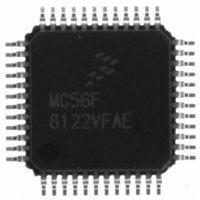MC56F8122VFAE Freescale Semiconductor, MC56F8122VFAE Datasheet - Page 97

MC56F8122VFAE
Manufacturer Part Number
MC56F8122VFAE
Description
IC DSP 16BIT 40MHZ 48-LQFP
Manufacturer
Freescale Semiconductor
Series
56F8xxxr
Datasheet
1.MC56F8122VFAE.pdf
(136 pages)
Specifications of MC56F8122VFAE
Core Processor
56800
Core Size
16-Bit
Speed
40MHz
Connectivity
SCI, SPI
Peripherals
POR, WDT
Number Of I /o
21
Program Memory Size
32KB (16K x 16)
Program Memory Type
FLASH
Ram Size
4K x 16
Voltage - Supply (vcc/vdd)
2.25 V ~ 3.6 V
Data Converters
A/D 6x12b
Oscillator Type
Internal
Operating Temperature
-40°C ~ 105°C
Package / Case
48-LQFP
Data Bus Width
16 bit
Processor Series
MC56F81xx
Core
56800E
Maximum Clock Frequency
40 MHz
Number Of Programmable I/os
21
Data Ram Size
8 KB
Operating Supply Voltage
- 0.3 V to + 4 V
Maximum Operating Temperature
+ 105 C
Mounting Style
SMD/SMT
Data Rom Size
8 KB
Minimum Operating Temperature
- 40 C
Lead Free Status / RoHS Status
Lead free / RoHS Compliant
Eeprom Size
-
Lead Free Status / Rohs Status
Lead free / RoHS Compliant
Available stocks
Company
Part Number
Manufacturer
Quantity
Price
Company:
Part Number:
MC56F8122VFAE
Manufacturer:
Freescale Semiconductor
Quantity:
10 000
EXAMPLE 1: If the system clock is the 8MHz crystal frequency because the PLL has not been set up,
the input clock will be below 12.8MHz, so PRDIV8=FM_CLKDIV[6]=0. Using the following equation
yields a DIV value of 19 for a clock of 200kHz, and a DIV value of 20 for a clock of 190kHz. This
translates into an FM_CLKDIV[6:0] value of $13 or $14, respectively.
EXAMPLE 2: In this example, the system clock has been set up with a value of 32MHz, making the FM
input clock 16MHz. Because that is greater than 12.8MHz, PRDIV8=FM_CLKDIV[6]=1.Using the
following equation yields a DIV value of 9 for a clock of 200kHz, and a DIV value of 10 for a clock of
181kHz. This translates to an FM_CLKDIV[6:0] value of $49 or $4A, respectively.
Once the LOCKOUT_RECOVERY instruction has been shifted into the instruction register, the clock
divider value must be shifted into the corresponding 7-bit data register. After the data register has been
updated, the user must transition the TAP controller into the RUN-TEST/IDLE state for the lockout
sequence to commence. The controller must remain in this state until the erase sequence has completed.
For details, see the JTAG Section in the 56F8300 Peripheral User Manual.
Note:
7.2.4
The recommended method of unsecuring a programmed device for product analysis of field failures is via
the backdoor key access. The customer would need to supply Technical Support with the backdoor key
and the protocol to access the backdoor routine in the Flash. Additionally, the KEYEN bit that allows
backdoor key access must be set.
An alternative method for performing analysis on a secured microcontroller would be to mass-erase and
reprogram the Flash with the original code, but modify the security bytes.
To insure that a customer does not inadvertently lock himself out of the device during programming, it is
recommended that he program the backdoor access key first, his application code second and the security
bytes within the FM configuration field last.
Freescale Semiconductor
Preliminary
Once the lockout recovery sequence has completed, the user must reset both the JTAG TAP controller
(by asserting TRST) and the device (by asserting external chip reset) to return to normal unsecured
operation.
Product Analysis
150[kHz]
150[kHz]
56F8322 Technical Data, Rev. 16
<
<
(
(
SYS_CLK
SYS_CLK
(DIV + 1)
(DIV + 1)
(2)(8)
(2)
)
)
<
<
200[kHz]
200[kHz]
Flash Access Blocking Mechanisms
97











